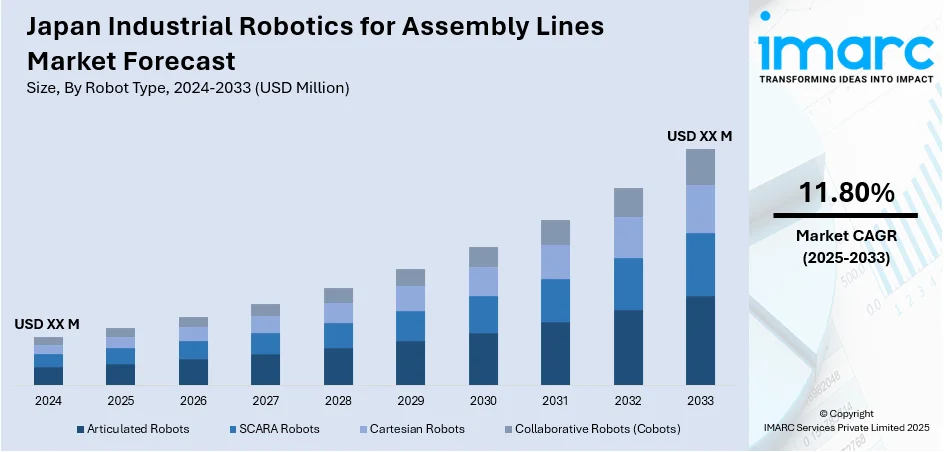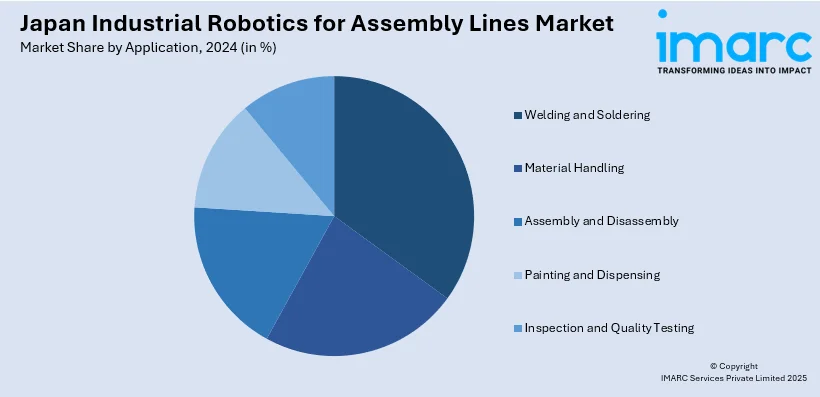
Japan Industrial Robotics for Assembly Lines Market Size, Share, Trends and Forecast by Robot Type, Payload Capacity, Application, End-Use, and Region, 2025-2033
Japan Industrial Robotics for Assembly Lines Market Overview:
The Japan industrial robotics for assembly lines market size is projected to exhibit a growth rate (CAGR) of 11.80% during 2025-2033. The market is expanding driven by increasing demand for advanced automation solutions. The rise in collaborative and autonomous robots enhances flexibility, productivity, and safety across sectors. This trend continues to strengthen Japan industrial robotics for assembly lines market share in various manufacturing industries.
|
Report Attribute
|
Key Statistics
|
|---|---|
|
Base Year
|
2024
|
|
Forecast Years
|
2025-2033
|
|
Historical Years
|
2019-2024
|
| Market Growth Rate 2025-2033 | 11.80% |
Japan Industrial Robotics for Assembly Lines Market Trends:
Transformation to Autonomous Robotics in Manufacturing
The deployment of autonomous robotic systems is driving the transformation of assembly line industrial robotics markets in Japan. Such advanced systems are designed to handle a series of complex operations under varying conditions, enabling the manufacturing process to be more efficient and accurate. For instance, the trend was demonstrated in July 2024 by RTJ when it showcased further developments of autonomous systems. Yaskawa Electric also launched an idea of "autonomous distributed manufacturing" meant to address production systems within low-volume, high-mix situations such as those existing within the automobile industry. The system allows robots to make situational judgments, which is essential for the automation of processes that have been difficult to manage in the past. Another fundamental consideration for companies seeking to save money without compromising quality is the ability of robots to autonomously adapt to varying manufacturing requirements. This growth contributes to Japan's industrial robotics segment for assembly lines by diversifying the industrial application of robotics. Autonomous robots contribute to curing the labor shortage, enhancement of product quality, and quicker production cycles, thereby accounting for the competitiveness of the manufacturing industry.

To get more information on this market, Request Sample
Innovation in Collaborative Robotics for Diverse Applications
Collaborative robots (cobots) are increasingly becoming a driving force in Japan’s industrial robotics for assembly lines market. These robots are designed to collaborate with human operators, providing flexibility and safety while enhancing productivity and efficiency. For instance, in September 2024, Kawasaki Robotics introduced its CL Series of cobots at IMTS, showcasing the next generation of industrial-grade collaborative robots. The CL Series cobots offer advanced capabilities in applications such as welding and machine tending and are designed to operate in challenging environments without the need for protective covers. This development allows manufacturers to enhance both speed and precision, improving overall production efficiency. These robots are not only safer and more flexible than traditional industrial robots but also more affordable and adaptable to various manufacturing processes. The introduction of the CL Series is expected to make automation accessible to a broader range of industries, particularly small and medium-sized enterprises, which may have previously found traditional robots cost-prohibitive. As industries continue to face labor shortages, the use of cobots in assembly lines will contribute to improving Japan industrial robotics market growth, enabling businesses to maintain high standards of production while reducing human error and rework.
Japan Industrial Robotics for Assembly Lines Market Segmentation:
IMARC Group provides an analysis of the key trends in each segment of the market, along with forecasts at the country and regional level for 2025-2033. Our report has categorized the market based on robot type, payload capacity, application, and end-use.
Robot Type Insights:
- Articulated Robots
- SCARA Robots
- Cartesian Robots
- Collaborative Robots (Cobots)
The report has provided a detailed breakup and analysis of the market based on the robot type. This includes articulated robots, SCARA robots, cartesian robots, and collaborative robots (Cobots).
Payload Capacity Insights:
- Up to 5 Kg
- 5 to 10 Kg
- 10 to 20 Kg
- Above 20 Kg
The report has provided a detailed breakup and analysis of the market based on the payload capacity. This includes Up to 5 Kg, 5 to 10 Kg, 10 to 20 Kg, and above 20 Kg.
Application Insights:

- Welding and Soldering
- Material Handling
- Assembly and Disassembly
- Painting and Dispensing
- Inspection and Quality Testing
The report has provided a detailed breakup and analysis of the market based on the application. This includes welding and soldering, material handling, assembly and disassembly, painting and dispensing, and inspection and quality testing.
End-Use Insights:
- Automotive
- Electronics and Semiconductor
- Metal and Machinery
- Plastics and Chemicals
- Food and Beverage
- Others
A detailed breakup and analysis of the market based on the end-use have also been provided in the report. This includes automotive, electronics and semiconductor, metal and machinery, plastics and chemicals, food and beverage, and others.
Regional Insights:
- Kanto Region
- Kansai/Kinki Region
- Central/ Chubu Region
- Kyushu-Okinawa Region
- Tohoku Region
- Chugoku Region
- Hokkaido Region
- Shikoku Region
The report has also provided a comprehensive analysis of all the major regional markets, which include Kanto Region, Kansai/Kinki Region, Central/ Chubu Region, Kyushu-Okinawa Region, Tohoku Region, Chugoku Region, Hokkaido Region, and Shikoku Region.
Competitive Landscape:
The market research report has also provided a comprehensive analysis of the competitive landscape. Competitive analysis such as market structure, key player positioning, top winning strategies, competitive dashboard, and company evaluation quadrant has been covered in the report. Also, detailed profiles of all major companies have been provided.
Japan Industrial Robotics for Assembly Lines Market News:
- April 2025: FANUC showcased advanced industrial and collaborative robotic solutions at Automate 2025, highlighting innovations like collaborative robots and autonomous mobile robots. These technologies emphasized efficiency and productivity, contributing to Japan’s industrial robotics for assembly lines market development by enhancing automation and flexibility in manufacturing.
- March 2025: Yaskawa Electric, in collaboration with Toyota, introduced a new robotic welding method, Sequence Freezing Arc-Welding (SFA). This innovation reduced production time for racing car roll cages from weeks to days, enhancing efficiency and precision in robotic welding, driving growth in Japan's industrial robotics for assembly lines market.
Japan Industrial Robotics for Assembly Lines Market Report Coverage:
| Report Features | Details |
|---|---|
| Base Year of the Analysis | 2024 |
| Historical Period | 2019-2024 |
| Forecast Period | 2025-2033 |
| Units | Million USD |
| Scope of the Report |
Exploration of Historical Trends and Market Outlook, Industry Catalysts and Challenges, Segment-Wise Historical and Future Market Assessment:
|
| Robot Types Covered | Articulated Robots, SCARA Robots, Cartesian Robots, Collaborative Robots (Cobots) |
| Payload Capacities Covered | Up to 5 Kg, 5 to 10Kg, 10 to 20 Kg, Above 20 Kg |
| Applications Covered | Welding and Soldering, Material Handling, Assembly and Disassembly, Painting and Dispensing, Inspection and Quality Testing |
| End-Use Covered | Automotive, Electronics and Semiconductor, Metal and Machinery, Plastics and Chemicals, Food and Beverage, Others |
| Regions Covered | Kanto Region, Kansai/Kinki Region, Central/ Chubu Region, Kyushu-Okinawa Region, Tohoku Region, Chugoku Region, Hokkaido Region, Shikoku Region |
| Customization Scope | 10% Free Customization |
| Post-Sale Analyst Support | 10-12 Weeks |
| Delivery Format | PDF and Excel through Email (We can also provide the editable version of the report in PPT/Word format on special request) |
Key Questions Answered in This Report:
- How has the Japan industrial robotics for assembly lines market performed so far and how will it perform in the coming years?
- What is the breakup of the Japan industrial robotics for assembly lines market on the basis of robot types?
- What is the breakup of the Japan industrial robotics for assembly lines market on the basis of payload capacity?
- What is the breakup of the Japan industrial robotics for assembly lines market on the basis of application?
- What is the breakup of the Japan industrial robotics for assembly lines market on the basis of end-use?
- What is the breakup of the Japan industrial robotics for assembly lines market on the basis of region?
- What are the various stages in the value chain of the Japan industrial robotics for assembly lines market?
- What are the key driving factors and challenges in the Japan industrial robotics for assembly lines market?
- What is the structure of the Japan industrial robotics for assembly lines market and who are the key players?
- What is the degree of competition in the Japan industrial robotics for assembly lines market?
Key Benefits for Stakeholders:
- IMARC’s industry report offers a comprehensive quantitative analysis of various market segments, historical and current market trends, market forecasts, and dynamics of the Japan industrial robotics for assembly lines market from 2019-2033.
- The research report provides the latest information on the market drivers, challenges, and opportunities in the Japan industrial robotics for assembly lines market.
- Porter's five forces analysis assist stakeholders in assessing the impact of new entrants, competitive rivalry, supplier power, buyer power, and the threat of substitution. It helps stakeholders to analyze the level of competition within the Japan industrial robotics for assembly lines industry and its attractiveness.
- Competitive landscape allows stakeholders to understand their competitive environment and provides an insight into the current positions of key players in the market.
Need more help?
- Speak to our experienced analysts for insights on the current market scenarios.
- Include additional segments and countries to customize the report as per your requirement.
- Gain an unparalleled competitive advantage in your domain by understanding how to utilize the report and positively impacting your operations and revenue.
- For further assistance, please connect with our analysts.
 Request Customization
Request Customization
 Speak to an Analyst
Speak to an Analyst
 Request Brochure
Request Brochure
 Inquire Before Buying
Inquire Before Buying




.webp)




.webp)












